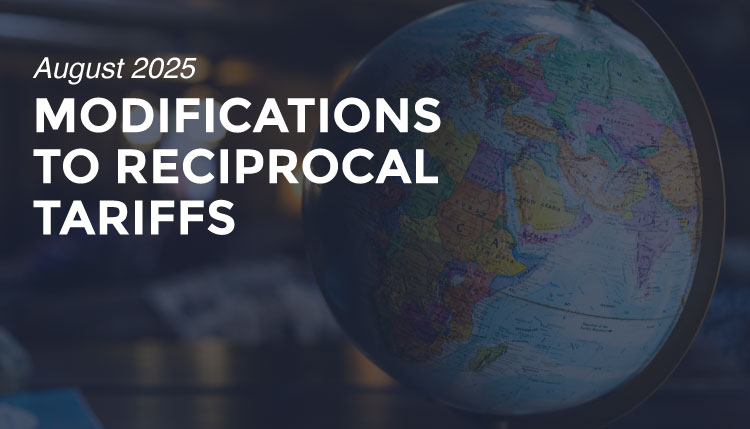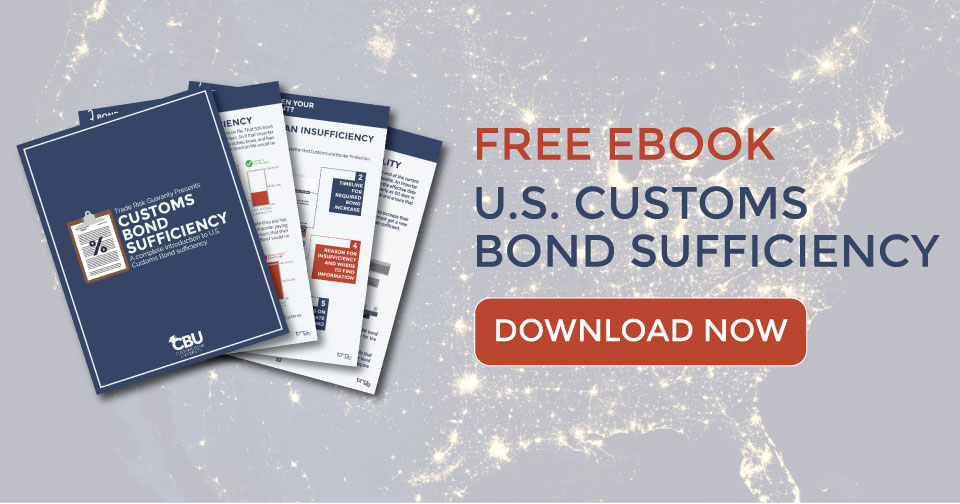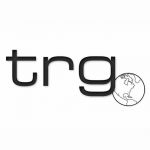Modifications to reciprocal tariffs have been announced and go into effect on August 7, 2025.
The evening of July 31st, President Trump issued an executive order outlining his updated plans in regards to the reciprocal tariffs originally put in place back in April. This update impacts the tariff rates placed on goods imported into the United States from many countries, but it also takes a harsher stance on transshipping.
The following is a brief breakdown of key components within this official announcement. However, you can read the full announcement directly on the White House’s website: Further Modifying the Reciprocal Tariff Rates.
When Do These Modifications to Reciprocal Tariffs Go Into Effect
Shipments that depart from the foreign port within seven days of August 1st and arrive to the U.S. and are cleared by U.S. Customs & Border Protection by October 5, 2025 will avoid the new reciprocal rates. Any shipment not matching this criteria will be subject to these tariffs.
Which Countries Are Impacted By The Modifications to Reciprocal Tariffs?
Ad Valorem rates were specified for over 65 countries in the official notice published by the White House, refer to the link above to read through the full publication. The tariff rates imposed on the countries listed below are in addition to any previously imposed duty rates. This means that these percentages stack on top of one another potentially making the final percentage paid upon entry higher than what is listed here.
Goods from countries not listed in Annex 1 are subject to an additional ad valorem rate of duty of 10% (imposed in Executive Order 14257, as amended) unless otherwise expressly provided.
The following are the countries listed in Annex 1 of this publication:
| Country | Tariff Rate | Country | Tariff Rate |
|---|---|---|---|
| Afghanistan | 15% | Algeria | 30% |
| Angola | 15% | Bangladesh | 20% |
| Bolivia | 15% | Bosnia and Herzegovina | 30% |
| Botswana | 15% | Brazil | 10%* |
| Brunei | 25% | Cambodia | 19% |
| Cameroon | 15% | Chad | 15% |
| Costa Rica | 15% | Côte d`Ivoire | 15% |
| Democratic Republic of the Congo | 15% | Ecuador | 15% |
| Equatorial Guinea | 15% | Falkland Islands | 10% |
| European Union: Goods with Column 1 Duty Rate[1] > 15% | 0% | European Union: Goods with Column 1 Duty Rate < 15% | 15% minus Column 1 Duty Rate |
| Fiji | 15% | Ghana | 15% |
| Guyana | 15% | Iceland | 15% |
| India | 25% | Indonesia | 19% |
| Iraq | 35% | Israel | 15% |
| Japan | 15% | Jordan | 15% |
| Kazakhstan | 25% | Laos | 40% |
| Lesotho | 15% | Libya | 30% |
| Liechtenstein | 15% | Madagascar | 15% |
| Malawi | 15% | Malaysia | 19% |
| Mauritius | 15% | Moldova | 25% |
| Mozambique | 15% | Myanmar (Burma) | 40% |
| Namibia | 15% | Nauru | 15% |
| New Zealand | 15% | Nicaragua | 18% |
| Nigeria | 15% | North Macedonia | 15% |
| Norway | 15% | Pakistan | 19% |
| Papua New Guinea | 15% | Philippines | 19% |
| Serbia | 35% | South Africa | 30% |
| South Korea | 15% | Sri Lanka | 20% |
| Switzerland | 39% | Syria | 41% |
| Taiwan | 20% | Thailand | 19% |
| Trinidad and Tobago | 15% | Tunisia | 25% |
| Turkey | 15% | Uganda | 15% |
| United Kingdom | 10% | Vanuatu | 15% |
| Venezuela | 15% | Vietnam | 20% |
| Zambia | 15% | Zimbabwe | 15% |
According to the publication, certain countries identified in Annex I have either agreed to or are on the verge of concluding “meaningful trade and security agreements with the United States”. Goods of these countries will remain subject to the additional tariffs listed above until those agreements are concluded and subsequent orders are issued.
*Concerning the Additional Tariffs for Imports from Brazil
Also announced last week in the publication Addressing Threats To The United States By The Government Of Brazil, an additional 40% IEEPA tariff is being imposed on Brazil. This makes the total tariff 50%.
Understanding the Reciprocal Tariffs on the European Union
The 15% tariff imposed on goods from the European Union does not stack on historic rates, referred to as “Column 1”. The administration has provided a provision unique to the EU that only charges duties on goods that have duty rates less than 15% and only the difference is charged.
In more straightforward terms, the total duty rate paid on goods from the EU is 15%. If your standard, Column 1, duty rate is less than 15%, an ad valorem duty will be imposed to make the total 15%. If your standard, Column 1, duty rate is more than 15%, no ad valorem duty will be imposed.
Specifications for Transshipping
Transshipping has always been a concern for U.S. Customs and Border Protection, but that concern has increased with the imposition of tariffs. In this most recent publication, actions have been specified for those that are determined to be transshipping.
Any shipment that is found to have been transshipped in order to evade the duties specified within this publication will be subject to an additional ad valorem rate of duty of 40% and any additional fines or penalties that may apply. Ultimately it is up to CBP to determine whether or not a shipment has been transshipped, but no details have been published on how CBP will be making this determination.





![[Webinar] How Could Changes to De Minimis Impact Your Company?](https://traderiskguaranty.com/trgpeak/wp-content/uploads/2025/05/trg-how-de-minimis-impacts-customs-bond-webinar-400x250.png)

![[Webinar] United States Reciprocal Tariffs – The What, Why, and How](https://traderiskguaranty.com/trgpeak/wp-content/uploads/2025/04/trg-webinar-reciprocal-tariffs-400x250.png)